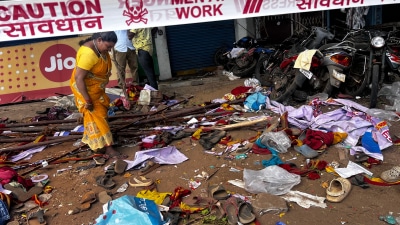Economy in a mess, confirms White Paper, proposes remedies
NAGPUR, DECEMBER 21: The much awaited White Paper on state's economy which was presented in both Houses of State Legislature by the Democr...

NAGPUR, DECEMBER 21: The much awaited White Paper on state’s economy which was presented in both Houses of State Legislature by the Democratic Front (DF) government on Monday has held the previous Sena-BJP alliance government’s extravagance solely responsible for pushing the state to the brink of bankruptcy in just four and a half years. Readers will recall that The Indian Express was first to report the shocking state of economy when a detailed report was submitted to chief minister Vilasrao Deshmukh soon after he took over the reins.
Citing several instances of large scale irregularities, utter lack of vision in planning and execution of schemes needing huge outlays, indiscriminate use of precious revenue for totally unproductive purposes and, above all, massive borrowings during last four and a half years without giving a thought to the repayment aspect, the paper alleges that the alliance government played havoc with the state economy. And as a result, the revenue deficit is at an all time high of over Rs 8,000 crore.
The paper claims that the state economy was carefully nursed by the successive Congress governments in 35 years but the alliance totally ruined the prosperous economy.
Now, the economy is burdened with loan repayment liability to such an extent that almost 95 per cent of its revenue is needed only for repayment of loans and paying salary and other administrative expenses. Unless some hard decisions are taken very soon, the state would soon fall in a debt-trap. It would then need further loans, not for completion of on-going projects or even for maintenance of already completed ones, but only for repaying loans and disbursing salaries, the paper warned.
Presenting a bleak picture of the state economy, the paper has suggested some medium and long term measures. These include reduction of work force in government departments by one to one and a half per cent every year by not filling up vacancies caused by retirements and also by offering Voluntary Retirement Scheme (VRS) to employees; drastic cut in grant-in-aid to educational institutions and allowing them to raise their own resources by charging higher fees from economically better off class; simplification of sales tax structure and computerisation of sales tax department to ensure higher tax collection; seeking long term and low interest loans to repay the existing loan; appointment of a high level committee to set priorities for allocation of funds for government schemes; keeping a strict vigil on government spending; discontinuing grants to unproductive purpose; reviewing the subsidy-based schemes; restructuring MSRTC and MSEB to help them come out of the red; setting up of a state-level board forfinancial and managerial restructuring, with powers to either close down loss making state undertaking or suggesting ways for disinvestment.
The DF government has come out with the 29-page document after an elaborate exercise, backing each and every charge levelled against the previous government by statistics. The loan liability, for instance, is so crippling that the state is now required to make provision for Rs 5,082 crore from its scarce resources to repay the loan and interest instalment this year alone. The amount would be more than doubled in next five years because the state is committed to repay the massive loan amount in specified time period. Moreover, the previous government has made commitments for repayment of even bigger loans and bonds raised by undertakings. The debt service liability on account of the loan raised by undertakings stands at Rs 7,384 crore in 1999-2000. In next five years, the burden will be to the tune of Rs 15,690 crore.
The paper lists several schemes which were initiated with much fanfare during the alliance rule but were ill-planned and implemented with total disregard to fiscal discipline. Among the schemes listed are rural water supply scheme, which was estimated to cost Rs 15,011, Maharashtra Krishna Valley Development Project, estimated to cost Rs 11,660 crore, Shivshahi Punarvasan Prakalp for rehabilitation of slum dwellers of Mumbai, scheme launched by MSRDC for construction of a series of flyovers in Mumbai, Zunka Bhakar scheme and Matoshri Vridhashram scheme for senior citizens. Bunglings in handling the affairs of Maharashtra State Road Transport Corporation (MSRTC), Maharashtra State Electricity Board (MSEB) and Maharashtra State Cooperative Cotton Growers Marketing Federation have also been included in the paper.
All these projects launched during the alliance rule were mismanaged. The result was a total chaos on all fronts. While only 15 per cent of the target was achieved in the ambitious rural water supply scheme, it was a ridiculous 0.00044 per cent in case of rehabilitation of slum dwellers in Mumbai. In case of Krishna Valley projects, the annual interest on loan has gone up by Rs 269 crore only because the alliance government opted for loans and bonds at higher rate of interest, the paper says.
The alliance decisions also hit hard the once financially strong MSRTC and MSEB. Both undertakings are deep in the red, with MSRTC’s losses crossing Rs 520 crore mark.
The MSEB suffered only because the alliance leaders continued to make announcement about free power supply to the farm sector but took no steps to implement it. As a result, the MSEB found it difficult to recover power charges from farmers. By the end of June 1999, the dues had mounted to all time high of Rs 3649 crore, including Rs 2003 crore from agriculture and industry sector and over Rs 800 crore from Mula-Pravara Cooperative Society alone. During the alliance rule, the Cotton Federation losses jumped to 1887 crore from Rs 90 crore in just four and a half years, the paper added.
Both Zunka Bhakar scheme and Matoshree Vridhashram Scheme also resulted in losses. While the expenditure of Rs 56.35 crore incurred on Zunka Bhakar scheme has failed to yield the desired results, the expenditure of Rs 16.28 crore on Vridhashram could provide accommodation to only 900-odd senior citizens. Other cases listed in the paper include, revenue losses due to tax exemption granted for the controversial Michael Jackson show in Mumbai and also to commercial Hindi films.






- 01
- 02
- 03
- 04
- 05

























